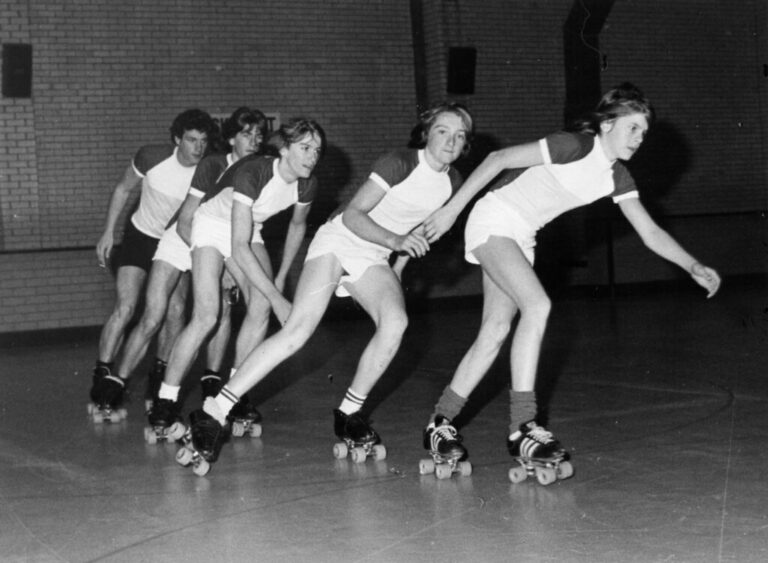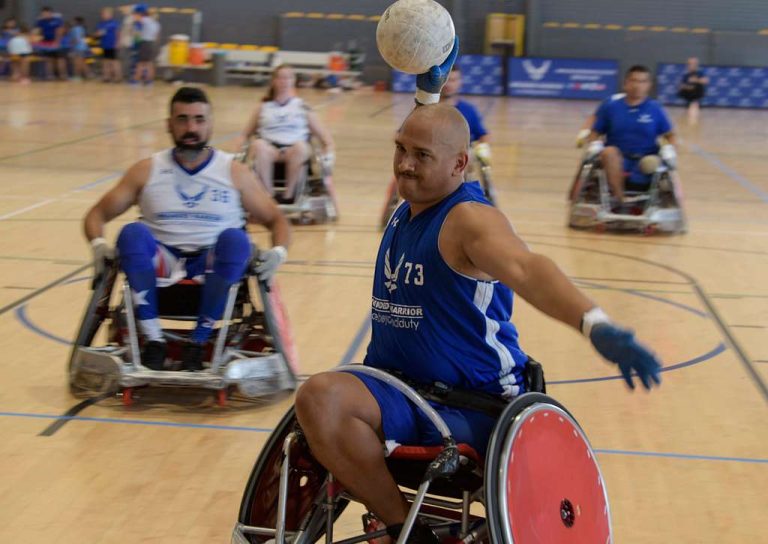General Rules of Playing Wallball
Wallball is a popular sport that is played by people of all ages and skill levels. It is a fast-paced and highly competitive game that requires agility, strategy, and quick reflexes.
In this article, we will cover everything you need to know about wallball, from the equipment you’ll need to set up the playing area.
Wallball can be played with just a ball and a wall, making it an accessible and affordable game for everyone. However, there are certain rules and guidelines that need to be followed to ensure a fair and enjoyable game. These rules not only add structure to the game but also enhance the safety of the players.

One of the most important aspects of wallball is the equipment. To play the game, you will need a rubber ball that is specifically designed for wallball. These balls are usually small and have a good bounce, allowing for fast and unpredictable gameplay. Additionally, players should wear appropriate sports shoes and comfortable clothing to ensure maximum mobility on the court.
Before starting the game, it is crucial to set up the playing area properly. The wall should be sturdy and free from any obstacles that could hinder the game. The playing area should also be marked with boundary lines to clearly define the court. This ensures that the ball stays within the designated area and prevents any disputes during the game.
Now that you have a basic understanding of the equipment and setup, let’s move on to the general rules of wallball. These rules govern various aspects of the game, including serving, scoring, and gameplay strategies. By familiarizing yourself with these rules, you will be able to play wallball confidently and enjoy the game to the fullest.
So, grab your racket and let’s get started on this thrilling journey into the world of wallball! Whether you’re a seasoned player looking to brush up on your skills or a beginner eager to learn, these rules will provide you with a solid foundation to excel in this exciting sport.
Equipment Needed for Wallball
To play wallball, you’ll need a ball and a wall. The type of ball you choose can greatly impact your game. The most common and recommended ball for wallball is a tennis ball. Its size, weight, and bounce make it ideal for this fast-paced game. A tennis ball is easy to grip and control, allowing for accurate throws and catches. It also bounces well off the wall, adding an exciting element to the game.
Another popular option is a rubber ball, commonly used in handball. These balls are slightly smaller and denser than tennis balls, providing a different feel and challenge. Rubber balls are known for their grip and durability, making them suitable for intense and competitive wallball matches.
When it comes to attire, there are no strict rules, but certain recommendations can enhance your playing experience. Comfortable athletic clothing is a good choice, allowing for unrestricted movement. Opt for breathable fabrics that wick away sweat to keep you cool and dry during intense gameplay. Proper footwear is also important to prevent slips and injuries. Sneakers with good traction and ankle support are ideal.
Setting up the Playing Area
Now that you have your equipment ready, let’s talk about how to set up the playing area for wallball. To ensure a fair and enjoyable game, it’s important to follow the proper dimensions and consider the different wall surfaces available. Here are the key aspects to keep in mind when setting up your wallball court:
-
Wallball court dimensions: The dimensions of a wallball court can vary depending on the available space. However, a standard court typically measures around 20 feet wide and 30 feet long. It’s important to have enough room for players to move around comfortably, so make sure to adjust the dimensions accordingly if needed.
-
Different wall surfaces: Wallball can be played on various wall surfaces, such as concrete, brick, or wood. Each surface may offer a slightly different playing experience. Concrete walls are commonly used and provide a good bounce for the ball. Brick walls can offer a more unpredictable bounce, adding an extra challenge to the game. Wood surfaces tend to absorb more of the ball’s energy, resulting in a lower bounce. Experiment with different surfaces to find the one that suits your preferences and playing style.
-
Marking the playing area: To clearly define the playing area, mark the boundaries of the court using chalk or tape. This will help prevent any disputes during the game and ensure that everyone knows where the ball should be played.
By following these guidelines, you can set up a well-defined and exciting wallball court. Remember, the playing area should provide freedom of movement while adhering to the standard dimensions. Don’t forget to consider the wall surface you’re playing on, as it can significantly impact the game.
Now you’re ready to start playing and enjoy the freedom of wallball!
Serving the Ball
After setting up the playing area for wallball, you can now begin serving the ball. The serve is a crucial part of the game, as it determines the start of each rally and can give you an advantage right from the beginning. There are different serving techniques you can use, each with its own benefits.
Here are three common serving techniques in wallball:
| Technique | Description |
|---|---|
| Overhand Serve | This is the most basic serve in wallball. You stand facing the wall and throw the ball overhand, making sure it hits the wall above the service line. This technique allows for a powerful serve and is great for starting the game with a strong shot. |
| Underhand Serve | The underhand serve is similar to the overhand serve, but instead of throwing the ball overhand, you throw it underhand. This technique is useful for aiming and placing the ball accurately, as it gives you more control over the direction and speed of the serve. |
| Sidearm Serve | The sidearm serve is a more advanced technique that involves throwing the ball from the side of your body. This technique can add spin to the ball, making it difficult for your opponent to return. It requires practice to master, but once you do, it can be a powerful tool in your arsenal. |
Having a strong serve is important in wallball because it sets the tone for the entire game. A strong serve can put pressure on your opponent right from the start and force them into a defensive position. It also gives you the opportunity to dictate the pace of the game and control the direction of the rally. So, make sure to practice your serving techniques and develop a strong serve to gain an advantage in the game.
Basic Rules of Gameplay
To play wallball, you must adhere to a set of basic rules that govern the gameplay. These rules ensure a fair and enjoyable experience for all players. Here are the key rules to keep in mind:
-
Serve the ball properly: The game begins with a serve. Stand behind the serving line and throw the ball against the wall, making sure it bounces before your opponent can catch it. Aim for a challenging spot on the wall to increase the difficulty.
-
Alternate turns: After the serve, players take turns hitting the ball against the wall. Each player must wait for the ball to bounce once before hitting it. Failure to do so results in a penalty. Keep the game flowing by alternating turns smoothly.
-
Avoid mistakes: There are a few common mistakes to watch out for during gameplay. One is failing to catch the ball after it bounces off the wall, which gives your opponent a point. Another mistake is hitting the ball out of bounds, causing a point deduction. Lastly, hitting the ball into the ground before it bounces off the wall isn’t allowed.
By following these basic rules, you can enjoy a fun and competitive game of wallball. Remember to practice various wallball techniques to improve your skills and keep the game challenging.
Keep an eye out for common mistakes to avoid penalties and maintain a fair gameplay. So grab a ball, find a wall, and enjoy the freedom of playing wallball!
Scoring and Point System
Now let’s talk about the points in wallball. Scoring is an essential aspect of the game, determining who comes out on top.
To earn points, you must hit the ball against the wall and make it bounce before your opponent can catch it. The number of points awarded will depend on the specific rules you’re playing with, so let’s delve into the scoring methods and point allocation breakdown.
Scoring Methods Explained
When playing wallball, understanding the scoring methods and point system is crucial. Here are three scoring methods commonly used in wallball games:
-
One Bounce Rule: In this method, if the ball bounces once before your opponent touches it, you score a point. However, if it bounces more than once or your opponent catches it before it bounces, no point is awarded.
-
No Bounce Rule: In this method, you score a point when you hit the wall without the ball bouncing first. Your opponent must then return the ball before it hits the ground to avoid giving you a point.
-
Catching Rule: In this method, you score a point when your opponent fails to catch the ball after it hits the wall. The ball must be caught cleanly without any bounces or touches on the ground.
Understanding these scoring methods will help you strategize and play the game effectively, whether you’re playing on different types of wallball courts or using common strategies.
Point Allocation Breakdown
Understand how points are allocated in wallball by familiarizing yourself with the scoring and point system. Scoring techniques may vary depending on the rules you are playing with, as different regions or groups may have their own variations. However, the general concept is to earn points by successfully hitting the ball against the wall and preventing your opponent from returning it. Here is a breakdown of a common point system used in wallball:
| Action | Points |
|---|---|
| Successful hit on the wall | 1 |
| Opponent fails to return the ball | 1 |
| Ball bounces twice before returned | 1 |
It’s important to note that point system variations can exist, so it’s always a good idea to clarify the rules before playing. With this understanding of point allocation, you can now confidently engage in a spirited game of wallball.
Out of Bounds and Fouls
To properly play wallball, you must understand the rules regarding out of bounds and fouls. These rules ensure fair play and maintain the integrity of the game. Here are the key things you need to know:
Out of bounds rules:
- When the ball hits an area outside the designated playing area, it’s considered out of bounds.
- If the ball bounces back into the playing area without touching the ground outside, the game continues.
- However, if the ball touches the ground outside the playing area or hits an obstruction (such as a fence) before bouncing back, it’s considered out of bounds, and the opposing player gains a point.
Common fouls:
- Hitting the ball with any body part other than your hand is a foul. You must use an open hand to strike the ball.
- If the ball hits the ground before you can catch it after your opponent’s throw, it’s a foul. You must catch the ball in the air for it to be considered a valid play.
- Intentionally blocking your opponent’s access to the ball or interfering with their throw is also a foul. Fair play and sportsmanship are essential in wallball.
Understanding the out of bounds rules and avoiding common fouls will help you play wallball with confidence and enjoy the game to its fullest. Remember, the goal is to have fun, challenge yourself, and showcase your skills while respecting the rules and your fellow players.
Strategies for Effective Wallball Play
Continuing from the previous subtopic on out of bounds and fouls, an effective strategy for playing wallball is to focus on positioning and anticipation. These strategies can greatly improve your chances of winning and enhance your accuracy and speed in the game.
One key strategy is to position yourself near the center of the court. This allows you to have better control over the ball and be in a prime location to react to any shots or rebounds. By staying in the center, you can quickly move in any direction and be ready to make a play.
Additionally, try to anticipate where the ball will go based on the trajectory and speed of your opponent’s shot. This will give you a head start in reaching the ball before your opponent does.
Another strategy to consider is to work on improving your accuracy and speed. To improve accuracy, practice hitting specific targets on the wall, such as corners or specific markings. This will help you develop better control over the ball and increase your chances of hitting your intended target during a game.
To improve speed, focus on quick reflexes and agility. Work on your footwork and reaction time to be able to reach the ball faster and make swift returns.
Incorporating these strategies into your wallball play can give you a competitive edge. By focusing on positioning and anticipation, as well as improving accuracy and speed, you’ll be better equipped to win games and outperform your opponents.
Variations and Additional Challenges
Ready to take your wallball skills to the next level?
Get ready for advanced rule modifications, increasing difficulty levels, and creative gameplay options that will challenge even the most seasoned player.
From adding extra points for specific shots to incorporating unique obstacles on the court, these variations and additional challenges will keep you on your toes and push you to improve your game.
Advanced Rule Modifications
For an added level of excitement and challenge in wallball, consider incorporating these variations and additional challenges into your game.
-
Target Zones: Create specific zones on the wall that players must hit with the ball to earn extra points. This adds a strategic element to the game as players must aim for these designated areas to maximize their score.
-
Time Challenges: Set a time limit for each round and see how many successful hits players can make within that timeframe. This increases the pressure and requires players to make quick decisions and accurate shots.
-
Obstacle Course: Place obstacles in the playing area that players must navigate while playing wallball. This adds an element of agility and coordination, forcing players to adapt their gameplay strategies to overcome the obstacles.
By implementing these advanced rule modifications and gameplay strategies, you can take your wallball skills to the next level and challenge yourself in new and exciting ways.
Enjoy the freedom to experiment and find what works best for you!
Increasing Difficulty Levels
To increase the difficulty levels of wallball, incorporate various variations and additional challenges into the game.
Advanced techniques can be introduced, such as using only your non-dominant hand, playing with a smaller ball, or adding spin to your throws. These techniques require more skill and coordination, making the game more challenging.
Additionally, you can implement advanced scoring methods to keep things interesting. For example, award extra points for hitting specific targets on the wall or for performing trick shots.
You can also introduce time limits for each player to complete their turn, adding a sense of urgency and pressure.
Creative Gameplay Options
To add more excitement and variety to your wallball game, there are several creative gameplay options and additional challenges you can explore. Here are three ideas to take your wallball skills to the next level:
-
Wallball Trick Shots: Get creative with your shots by incorporating different techniques and angles. Try bouncing the ball off the wall before hitting it, or aim for specific targets on the wall. Experiment with spin and trajectory to keep your opponents guessing.
-
Wallball Obstacle Courses: Set up obstacles or targets around the playing area to add an extra challenge. You can place cones or markers that players have to navigate around while playing. This not only tests your wallball skills but also improves agility and coordination.
-
Time Challenges: Set a timer and challenge yourself or your friends to complete a certain number of successful wallball hits within a specific timeframe. This adds a sense of urgency and encourages quick thinking and accurate shots.
Etiquette and Sportsmanship in Wallball
When playing wallball, it’s important to demonstrate good etiquette and sportsmanship by always respecting the rules and treating your opponents with fairness and kindness. Fair play and respect are the cornerstones of any game, and wallball is no exception. As you engage in this exciting and fast-paced sport, it’s crucial to remember that your actions can have a significant impact on the overall experience for everyone involved.
One key aspect of etiquette in wallball is to always play by the rules. This means not cutting corners or bending the rules to gain an unfair advantage. It’s essential to understand and follow the agreed-upon rules of the game, as this ensures fair competition and a level playing field for all participants. By doing so, you show respect for the game and your opponents.
Additionally, building camaraderie and teamwork is another vital aspect of wallball etiquette. Wallball isn’t just a game of individual skill, but also an opportunity to work together and support your teammates. Encouraging and uplifting your fellow players can enhance the overall experience and create a positive atmosphere. Remember to celebrate each other’s successes and offer support during challenging moments. This sense of camaraderie and teamwork not only helps in building strong relationships but also contributes to a more enjoyable and collaborative game.
Frequently Asked Questions
Can I Use Any Type of Ball to Play Wallball?
Sure, you can use different types of balls to play wallball. However, it’s recommended to use a specific type of ball for the best experience.
Using a rubber ball with good bounce and durability can enhance your gameplay. It allows for better control and accuracy when hitting the wall.
Are There Any Specific Dimensions for the Playing Area?
To play wallball effectively, it’s crucial to understand the dimensions of the playing area. This ensures fairness and a level playing field. By having specific dimensions, it allows players to strategize and plan their moves accordingly.
Additionally, proper footwork is key in wallball. It helps you stay agile and ready to defend the wall effectively. So, be mindful of the dimensions and focus on your footwork to dominate the game.
What Happens if the Ball Hits the Ground Before Reaching the Wall?
If the ball hits the ground before reaching the wall in Wallball, it’s considered a fault. According to the rules of the game, the ball must make contact with the wall directly without touching the ground first.
If this happens, you’ll lose your turn and the game will continue with the next player. It’s important to aim carefully and make sure the ball reaches the wall without any ground contact to keep the game going smoothly.
Are There Any Penalties for Fouls or Out of Bounds?
When it comes to penalties for fouls or going out of bounds in wallball, there are a few things to keep in mind.
If you commit a foul, such as interfering with another player or intentionally hitting the ball out of turn, there may be consequences.
Going out of bounds can also result in penalties, as it disrupts the flow of the game.
It’s important to play fair and stay within the designated playing area to avoid any penalties or consequences.
How Can I Improve My Aim and Accuracy in Wallball?
Looking to improve your aim and accuracy in wallball? Start by practicing techniques that enhance hand-eye coordination. Focus on tracking the ball with your eyes and making precise contact with your hand.
Experiment with different wall surfaces to adjust your aim and accuracy accordingly. Is the wall smooth or rough? Are there any obstacles? These factors can affect the bounce and trajectory of the ball.
Keep practicing and refining your skills to become a wallball pro!





